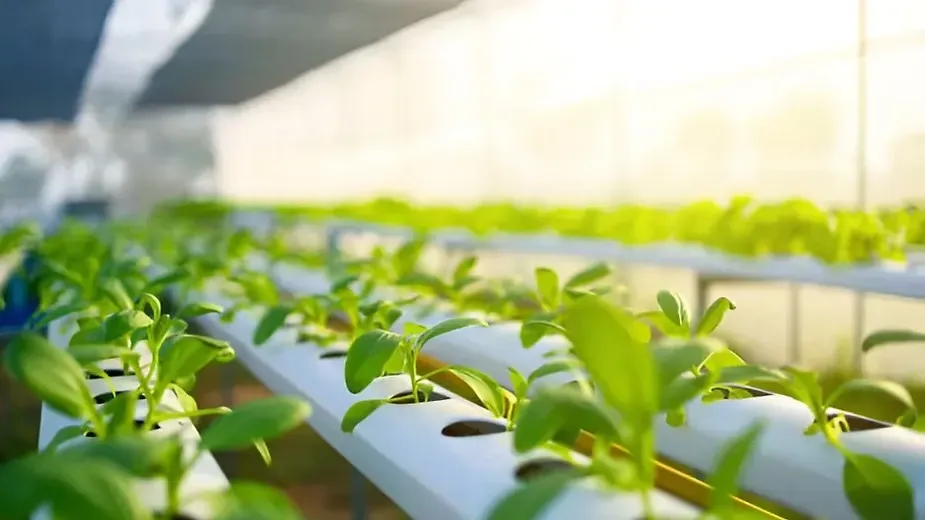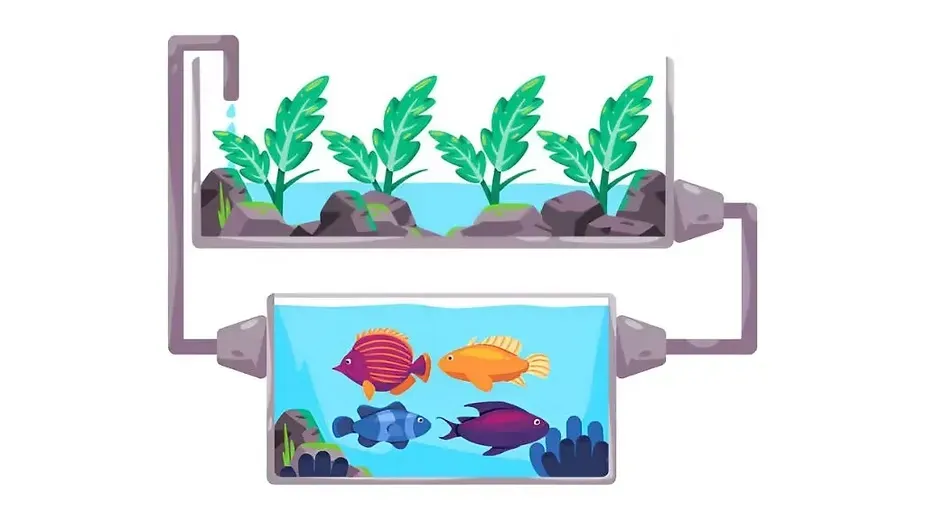Hydroponics vs Aquaponics: A Complete Guide to Understanding and Choosing the Right System!
Published on July 28, 2025

Key Takeaways:
|
Choosing between hydroponics and aquaponics can be a game-changer for your gardening or farming endeavours. Both systems represent cutting-edge approaches to cultivation, each with its unique advantages.
This guide delves into the difference between hydroponics and aquaponics, providing detailed insights into their operations and benefits and explaining how to determine which system aligns with your goals.
What is Hydroponics?

Hydroponics is an advanced method of growing plants without soil, using nutrient-rich water solutions to deliver essential nutrients directly to the plant roots. Instead of soil, plants are supported by inert mediums like perlite, coconut coir, or rock wool. These mediums anchor the plants but do not provide any nutrients. The nutrients are delivered via water, carefully monitored and adjusted to ensure optimal growth conditions.
1. Precision Nutrient Control
Hydroponics allows for precise control of nutrient levels, directly delivering the perfect mix to plant roots. This results in faster growth and higher yields compared to traditional soil-based farming. By optimizing nutrient delivery, waste is minimized, making the process more sustainable and cost-effective. This level of control ensures plants receive exactly what they need, leading to healthier crops and more efficient production.
2. Water Efficiency
Hydroponic systems are highly water-efficient, using up to 90% less water than traditional farming. By recycling and reusing water in a closed-loop system, hydroponics minimizes water waste, making it ideal for areas with limited water resources. This efficiency also translates into lower costs and a reduced environmental impact, highlighting hydroponics as a sustainable farming method.
3. Space Utilization
Hydroponics maximizes space by allowing for dense planting and vertical farming, making it perfect for urban environments and areas with limited land. Unlike traditional farming, hydroponics can thrive in small spaces like rooftops or indoors, producing more food per square foot. This flexibility makes it an ideal solution for urban agriculture and non-traditional farming locations.
What is Aquaponics?

Aquaponics is a synergistic farming system that combines hydroponics with aquaculture (fish farming). In an aquaponic system, fish are raised in tanks, and their waste products are broken down by beneficial bacteria into nutrients that are used to fertilize plants. The plants contribute by filtering and purifying the water, which is then recirculated back to the fish tanks, creating a harmonious, self-sustaining ecosystem.
1. Integrated Ecosystem
Aquaponics creates a harmonious balance between fish and plants, where the waste produced by the fish provides essential nutrients for the plants. The plants then naturally cleanse and purify the water, which is cycled back into the fish tanks. This closed-loop system emulates natural ecosystems, offering a highly sustainable approach to farming. The integration of these two elements leads to a productive, efficient, and environmentally friendly system that requires minimal external inputs.
2. Resource Efficiency
Aquaponics is exceptionally resource-efficient, utilizing far less water and fertilizer than traditional farming methods. The system continuously recycles water, meaning there’s very little waste, making it particularly advantageous in areas with water scarcity. Nutrients are naturally sourced from fish waste, reducing the need for chemical fertilizers. This efficiency not only cuts costs but also minimizes the environmental footprint, making aquaponics a smart choice for sustainable agriculture.
3. Dual Production
One of the standout features of aquaponics is its ability to produce both fish and plants in a single system. This dual production offers farmers the opportunity to diversify their output, providing fresh vegetables and protein-rich fish. The combined production can lead to higher profits and reduced market risks, as it allows for the sale of multiple products. This versatility makes aquaponics a compelling option for those looking to maximize their farming potential.
Difference Between Hydroponics & Aquaponics
Understanding the difference between hydroponics and aquaponics is crucial for choosing the right system for your needs:
Key Difference | Hydroponics | Aquaponics |
Nutrient Source | The nutrients plants need are directly dissolved into the water, allowing growers to fine-tune the nutrient mix for optimal growth. This precision ensures that plants receive exactly what they need at each stage of development. | It relies on fish waste as a natural nutrient source, creating a symbiotic relationship where the fish provide essential nutrients for the plants. This natural nutrient cycle eliminates the need for chemical fertilizers, making aquaponics a more sustainable option, though it requires careful balancing to maintain system health. |
System Complexity | Hydroponic systems are generally straightforward, focusing on the growth of plants in a controlled environment without soil. The simplicity of hydroponics makes it easier to manage and scale, especially for those new to soilless farming. | The difference between hydroponics and aquaponics lies in the complexity of the systems. Aquaponics involves not only nurturing plants but also managing fish health. This dual focus adds a layer of complexity, but it also creates a more integrated and self-sustaining system. The challenge of maintaining balance in aquaponics can be rewarding, offering a richer, more diverse farming experience. |
Environmental Impact | Aquaponics is often praised for its minimal environmental impact. The system recycles water continuously, drastically reducing water use compared to traditional farming. Additionally, fish waste is converted into nutrients for the plants, reducing the need for synthetic fertilizers and minimizing waste. | The difference between hydroponics and aquaponics becomes clear here—while hydroponics is also water-efficient, it requires external inputs such as nutrient solutions and energy to maintain ideal growing conditions. Although both systems are more sustainable than conventional farming, aquaponics tends to have a lower environmental footprint due to its closed-loop, waste-reducing nature. |
Advantages of Aquaponics
The advantages of aquaponics extend beyond simple nutrient delivery:
- Sustainable Water Use: Aquaponics systems are incredibly water-efficient, using up to 95% less water compared to traditional farming methods. This is achieved by constantly recycling water within the system, where it flows between the fish tank and the plant beds. The plants help purify the water before it returns to the fish, reducing the need for frequent water changes. One of the key advantages of aquaponics is that it not only conserves water but also creates a more sustainable agricultural practice, making it ideal for regions with limited water resources.
- Natural Pest Management: Aquaponics promotes a healthy, balanced ecosystem that naturally controls pests without the need for chemical pesticides. The integration of fish, plants, and beneficial microorganisms creates an environment where pests are less likely to thrive. This approach leads to healthier plant growth and reduces the risk of introducing harmful chemicals into the food chain. By relying on natural processes, aquaponics supports organic farming principles and produces cleaner, safer food.
- Increased Efficiency: Aquaponics maximizes resource efficiency by combining fish farming and plant cultivation in a single, closed-loop system. The fish produce waste that supplies vital nutrients for the plants, and in return, the plants purify and cleanse the water for the fish. This symbiotic relationship allows both plants and fish to thrive, resulting in higher overall productivity. One of the key advantages of aquaponics is its ability to recycle resources, making it a cost-effective and sustainable method for producing food, especially in areas with limited space or resources.
Hydroponics Vs. Aquaponics
When deciding between hydroponics and aquaponics, consider your goals and resources:
- Hydroponics is ideal if you seek precise control over plant nutrients and are interested in a simpler setup with a focus on plant production:
Hydroponics allows you to meticulously manage the nutrient levels that plants receive, providing an environment where they can grow quickly and efficiently.
This method is especially appealing to those who want to maximize plant yield in a controlled setting, such as an indoor or urban farm.
When comparing aquaponics vs hydroponics, the simplicity of hydroponics, which focuses solely on plant cultivation, makes it easier to manage, requiring fewer variables and less ongoing maintenance.
For growers who prioritize precision and efficiency, hydroponics offers a straightforward approach to achieving optimal plant health and productivity.
- Aquaponics is suitable if you want a sustainable, integrated system that offers both plant and fish production, with a focus on resource recycling and environmental benefits:
Aquaponics combines the cultivation of plants with fish farming, creating a symbiotic environment where each component supports the other.
Fish waste delivers crucial nutrients to the plants, while the plants, in turn, naturally purify and cleanse the water for the fish, promoting a healthier system overall.
When evaluating aquaponics vs hydroponics, aquaponics stands out as the ideal choice for those deeply committed to sustainability and reducing their environmental footprint.
This system's efficiency in recycling water and minimizing waste makes it a more eco-friendly alternative to traditional farming.
Additionally, the dual production of both fish and plants not only diversifies output but also offers a comprehensive and rewarding approach to farming, aligning with broader environmental goals.
Conclusion
The debate of hydroponics vs aquaponics offers exciting possibilities for innovative cultivation. Each system brings its own set of advantages and can be tailored to meet specific needs.
By understanding the nuances of both methods, you can choose the one that aligns with your objectives and resources, paving the way for successful and sustainable farming practices.
Dive into the world of advanced agriculture with confidence and make the most of these transformative technologies!
